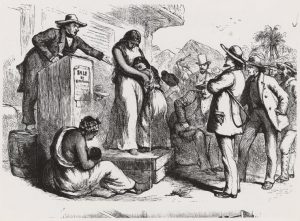Miqueas Molano
ENG 302
Professor Kappes
03/15/2018
Know your Audience
Artifacts and literature from the 18th century have a way of displaying the truth in subtle ways as to not offend the white demographic of the time. Audiences were veiled when presented with the harsh realities of their society by artists and poets. A sketch from the Public Library of New York Archives titled “Woman and Child on Auction Block” depicts the sorrow between a woman and her child holding on to each other while they are being auctioned off to a potential buyer to exploit their labor and possibly abuse them as well. Yet the picture, although it showcases the sadness between them, does not bring any detail of the sadness in their faces. Their faces are barely visible and since the drawing is simple and black and white it doesn’t convey the essence of the moment as a detailed colored painting would. In Phyllis Wheatley’s Poem “On being brought from AFRICA to AMERICA” it also has a subtle way of displaying the truth to an audience. It has a tone of sarcasm, using what the colonizers’ preach against them and alluding to the hypocrisy of their actions.
In her poem “On being brought from AFRICA to AMERICA” Wheatley states, “’TWAS mercy that brought me from my pagan land.”(1) Although at first glance one may think that her soul was being saved by these kidnappers, it becomes clear she doesn’t believe that at all. She was kidnapped and made a slave in America. No one would logically think that it was a merciful act being stripped away from their homeland and family to be “brought”(1) to a country where people of color are threatened into slave labor to be exploited. Those who tried to oppose were severely punished. Wheatley was aware of the gravity of her situation so she used a subtle tone of sarcasm as a veil to carry out the message she wanted without outright declaring her true opinions. She did this because she was aware of her duality in that society, she knows of her African roots even though she was kidnapped and made a slave in America to serve her “merciful” masters. She voiced her experience through a lens for her safety. Furthermore, Wheatley discussed the “angelic train” (8) which was a reference to joining the Christianity in order to be saved from their pagan land. The colonizers believed that the Africans who they abducted and trafficked were not civilized. In fact, they believed them to be savages. The destruction of a people’s culture and community is resembles nothing close to Christianity. The gravity of their heinous acts is softened by the language in the poem for the audience Wheatley was conveying to in order maintain her safety yet the tone hints at their contradictions. The same could be said of the object. Although it depicts a slave auction taking place with a woman and her child, the picture is drawn almost cartoon-like. It does show some sadness but it doesn’t truly capture the severity of that atrocity. When examined closely, one can see in the background a white man about to crack his whip on a slave. This was also done on purpose. It shows what is about to happen to the slave but it is so far in the background that one doesn’t take notice of it at first glance. This also softens the blow of their actions but was most likely the only way, to tell the truth without actually painting the traders as heinous villains and more along crooked businessmen. Both works display the truth but in order to really get a better understanding of what is truly being presented one must look closely.
The possible reasons why the creators have chosen to create their work could have been in fear for their life like Wheatley or to lessen the seriousness of their actions like in the artifact. We do not know what race created the artifact, therefore, cannot speak if it was to reduce the acts committed by the colonizers to a white audience or to discreetly display the suffering of the black slave to a black audience though it’s clear it was tailored to an audience. As I once stated, when creating such works with heavy themes such as slavery it is important how it is delivered to an audience during that time period where it was highly practiced in society. One must also take into consideration where they stand on the social ladder because certain liberties could be taken if you are in a privileged race.


